 |
OTTAWA CHAPTER - 05/06/2025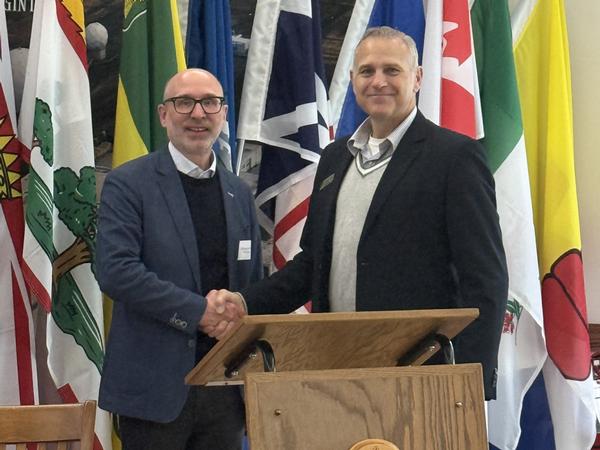 During the May luncheon, attendees heard Philippe Hebert, director general of the Defence Research and Development Canada Innovation Team, remark on some of the successful outcomes of the Innovation for Defence Excellence and Security (IDEaS) program. The intent of the program is to connect creative thinkers and innovative solutions with those who have identified specific defence and security challenges within the Department of National Defence/Canadian Armed Forces.
During the May luncheon, attendees heard Philippe Hebert, director general of the Defence Research and Development Canada Innovation Team, remark on some of the successful outcomes of the Innovation for Defence Excellence and Security (IDEaS) program. The intent of the program is to connect creative thinkers and innovative solutions with those who have identified specific defence and security challenges within the Department of National Defence/Canadian Armed Forces.The IDEaS program will be investing $1.6 billion in innovations for defence and security over the next 20 years. To date, an astonishing 9,000 innovators have been added to the ecosystem. With future contests and competitive project challenges scheduled in the coming months, subscribing to their mailing list is recommended. https://www.canada.ca/en/department-national-defence/programs/defence-ideas/subscribe.html |
OTTAWA CHAPTER - 04/23/2025 It was an early start for many as they heard encouraging words from Ross Ermel, assistant deputy minister for Digital Services and defence chief digital officer, Department of National Defence/Canadian Armed Forces. He reiterated that "fast execution requires a fast strategy" to contribute to the outcomes of the amalgamated digital services group. Of the 30-plus projects under his purview, such as Arctic Over-the-Horizon Radar, DEFENCEx and a federated identity project (working in partnership with the U.S. Department of Defense), he noted how these were examples where "success breeds more success." Before moving to Q&A, he reviewed the edge-to-enterprise approach being implemented and how it is supported by the group's vision to connect, enable and transform with an ultimate mission to foster a trusted ecosystem.
It was an early start for many as they heard encouraging words from Ross Ermel, assistant deputy minister for Digital Services and defence chief digital officer, Department of National Defence/Canadian Armed Forces. He reiterated that "fast execution requires a fast strategy" to contribute to the outcomes of the amalgamated digital services group. Of the 30-plus projects under his purview, such as Arctic Over-the-Horizon Radar, DEFENCEx and a federated identity project (working in partnership with the U.S. Department of Defense), he noted how these were examples where "success breeds more success." Before moving to Q&A, he reviewed the edge-to-enterprise approach being implemented and how it is supported by the group's vision to connect, enable and transform with an ultimate mission to foster a trusted ecosystem.
|
OTTAWA CHAPTER - 04/01/2025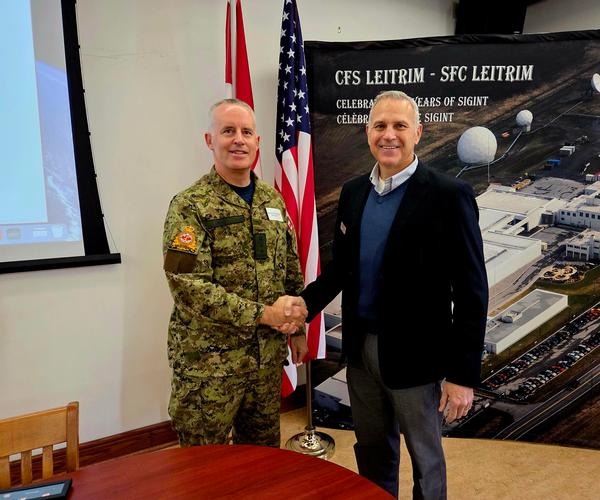 In April, Maj. Gen. Chris Zimmer, Digital Services Group (DSG), walked attendees through how the DSG intends to break down stovepipes and shift paradigms of the existing 170-plus networks and more than 3,000 apps to create a DSG for tomorrow.
In April, Maj. Gen. Chris Zimmer, Digital Services Group (DSG), walked attendees through how the DSG intends to break down stovepipes and shift paradigms of the existing 170-plus networks and more than 3,000 apps to create a DSG for tomorrow. During the chapter's luncheon, the chief digital transformation/defence chief data officer described his role as being as difficult as "solving world hunger." Zimmer discussed the seven priorities for the group, including the strategy on data, artificial intelligence and cloud. He also highlighted the need to be a global member and credible partner within the Five Eyes to help with the journey. |
OTTAWA CHAPTER - 02/04/2025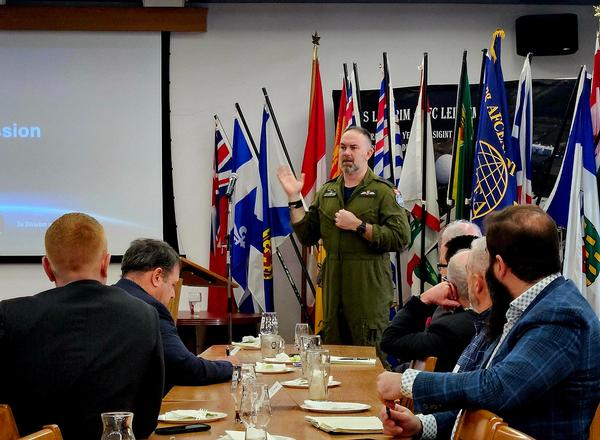 In February, at the Leitrim All Ranks Mess, attendees were taken through the responsibilities of 3 Canadian Space Division by Brig. Gen. Christopher Horner, commander. Horner provided insights into the relationship with the Royal Canadian Air Force as well as national and international partners. "Cooperation, Coordination and Integration" are the keys to operational flexibility and the ability to move fast in the four mission areas. The luncheon sponsor was Oracle.
In February, at the Leitrim All Ranks Mess, attendees were taken through the responsibilities of 3 Canadian Space Division by Brig. Gen. Christopher Horner, commander. Horner provided insights into the relationship with the Royal Canadian Air Force as well as national and international partners. "Cooperation, Coordination and Integration" are the keys to operational flexibility and the ability to move fast in the four mission areas. The luncheon sponsor was Oracle.
|
OTTAWA CHAPTER - 01/14/2025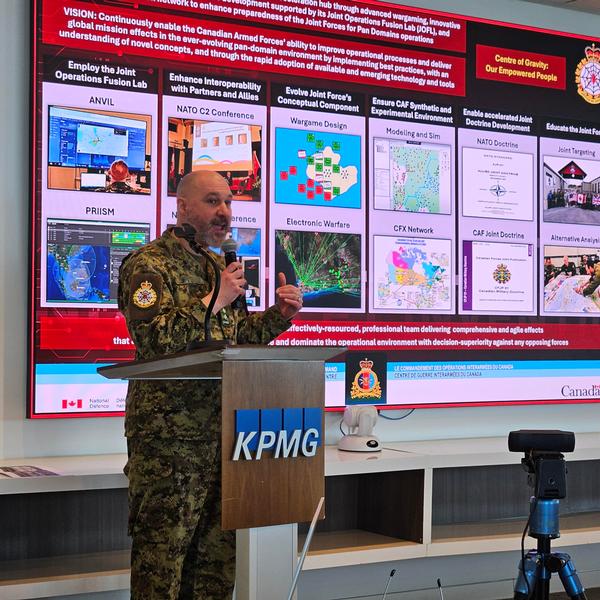 Col. Yannick Michaud, commander of the Canadian Joint Warfare Centre (CJWC), spoke about the vision and mission of the centre. He emphasized the people and tools that make up the "realm of possible," regarding the operational effects across the full spectrum of conflict. It is not only a centre of excellence to educate joint forces. Attendees also heard how the CJWC is using modeling and simulations to minimize risk and how they conduct "specialized" wargames. The luncheon was hosted at the KPMG office downtown and was sponsored by Black 8 Consulting.
Col. Yannick Michaud, commander of the Canadian Joint Warfare Centre (CJWC), spoke about the vision and mission of the centre. He emphasized the people and tools that make up the "realm of possible," regarding the operational effects across the full spectrum of conflict. It is not only a centre of excellence to educate joint forces. Attendees also heard how the CJWC is using modeling and simulations to minimize risk and how they conduct "specialized" wargames. The luncheon was hosted at the KPMG office downtown and was sponsored by Black 8 Consulting.
|
OTTAWA CHAPTER - 12/03/2024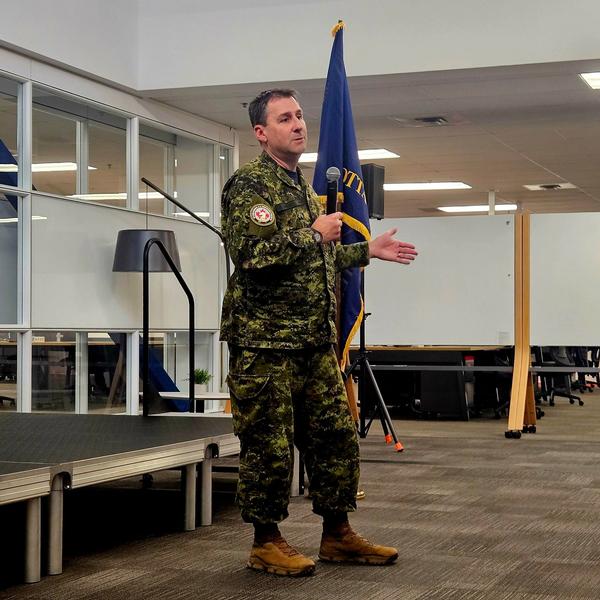 Col. Corey Crosby, chief, Joint Cyber Centre at the Department of National Defence, provided a briefing on the recently established Canadian Armed Forces Cyber Command (CAFCYBERCOM) during the December luncheon. Col Crosby walked attendees through the CAFCYBERCOM priorities, which are spread across domestic, expeditionary and partners, ensuring cyber operations and cyber mission assurance. Attendees also gained valuable insights into the organizational structure and role of each group involved, including the partnership with the Canadian Security Establishment.
Col. Corey Crosby, chief, Joint Cyber Centre at the Department of National Defence, provided a briefing on the recently established Canadian Armed Forces Cyber Command (CAFCYBERCOM) during the December luncheon. Col Crosby walked attendees through the CAFCYBERCOM priorities, which are spread across domestic, expeditionary and partners, ensuring cyber operations and cyber mission assurance. Attendees also gained valuable insights into the organizational structure and role of each group involved, including the partnership with the Canadian Security Establishment.
|
OTTAWA CHAPTER - 11/05/2024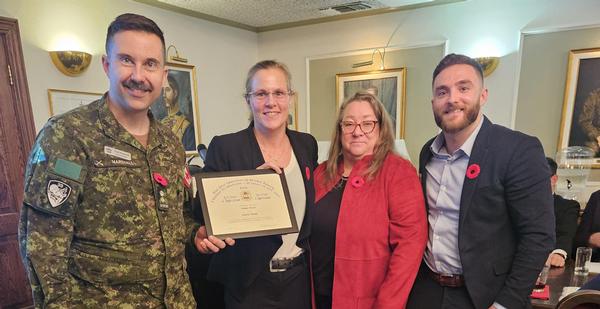 Sophie Martel, assistant deputy minister and chief technology officer for Department of National Defence/Canadian Armed Forces, spoke during the November chapter luncheon. Martel's message, "Think big, start small and iterate," included reviewing seven priorities and how their success relies on fostering a trusted digital ecosystem between the defense, government, international and technology teams.
Sophie Martel, assistant deputy minister and chief technology officer for Department of National Defence/Canadian Armed Forces, spoke during the November chapter luncheon. Martel's message, "Think big, start small and iterate," included reviewing seven priorities and how their success relies on fostering a trusted digital ecosystem between the defense, government, international and technology teams.
|
|
OTTAWA CHAPTER - 12/08/2020 The chapter held a three-day event sponsored by Microsoft Canada and covering the Canadian Security Assessment and Authorization (SA&A) cloud certification process. The event addressed topics such as SA&A Foundations, How Hyperscale Changes the Context, Leveraging International Certifications and SA&A Certifications Specifically for Hyperscale Cloud. The chapter rounded off the three-day event with a practitioner's panel of government of Canada chief information security officers and senior advisors. |
|
OTTAWA CHAPTER - 12/06/2016 |
|
OTTAWA CHAPTER - 12/01/2016 |
|
OTTAWA CHAPTER - 11/01/2016 |
OTTAWA CHAPTER - 10/04/2016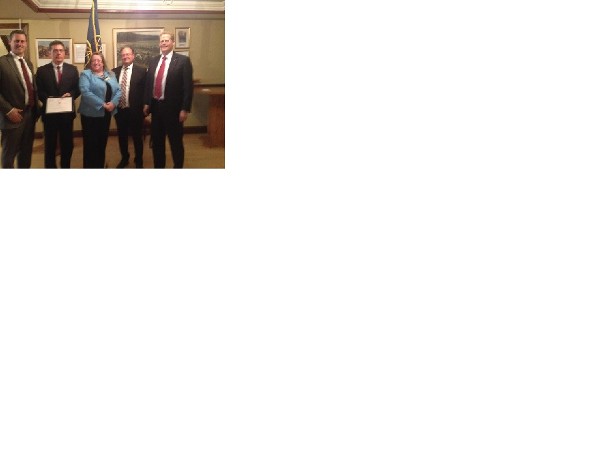 Andre Fillion, chief of staff, Department of National Defence (DND), was the guest speaker at the chapter's October luncheon. He gave a high level overview of the sustainment initiative and how this strategic change initiative involving DND, Public Services and Procurement Canada and Innovation, Science and Economic Development Canada is aimed at maximizing system performance, value for money, flexibility and economic benefits for military equipment. He also provided an overview of the implementation strategy and current status.
Andre Fillion, chief of staff, Department of National Defence (DND), was the guest speaker at the chapter's October luncheon. He gave a high level overview of the sustainment initiative and how this strategic change initiative involving DND, Public Services and Procurement Canada and Innovation, Science and Economic Development Canada is aimed at maximizing system performance, value for money, flexibility and economic benefits for military equipment. He also provided an overview of the implementation strategy and current status.
|
|
OTTAWA CHAPTER - 05/03/2016 |
|
OTTAWA CHAPTER - 04/27/2016 |
|
OTTAWA CHAPTER - 03/03/2016 |
|
OTTAWA CHAPTER - 03/01/2016 |
|
OTTAWA CHAPTER - 02/02/2016 |
OTTAWA CHAPTER - 01/15/2015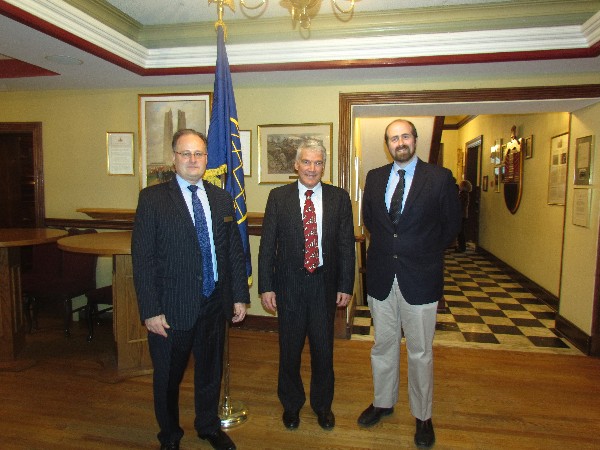
|
OTTAWA CHAPTER - 12/01/2015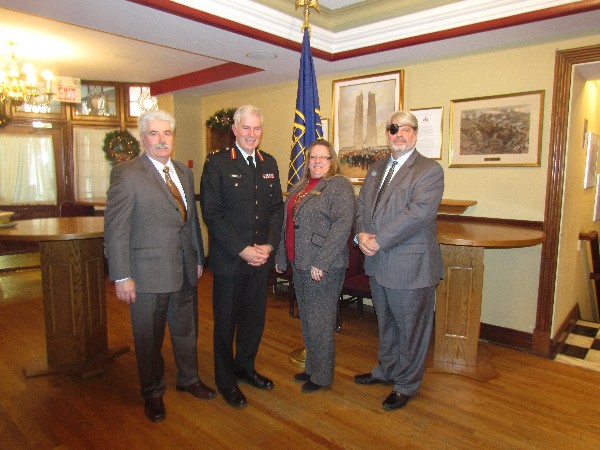
|
OTTAWA CHAPTER - 11/03/2015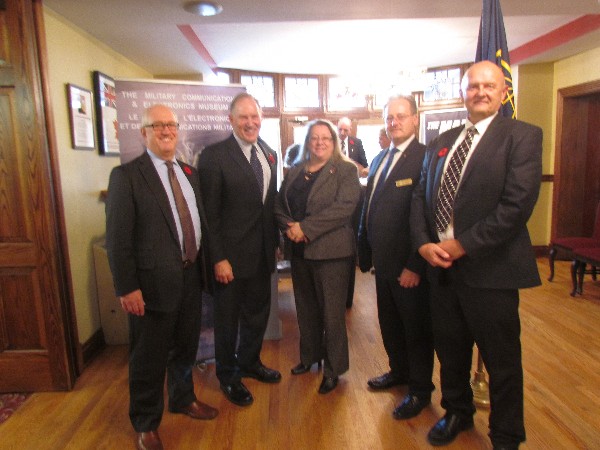
|
OTTAWA CHAPTER - 10/06/2015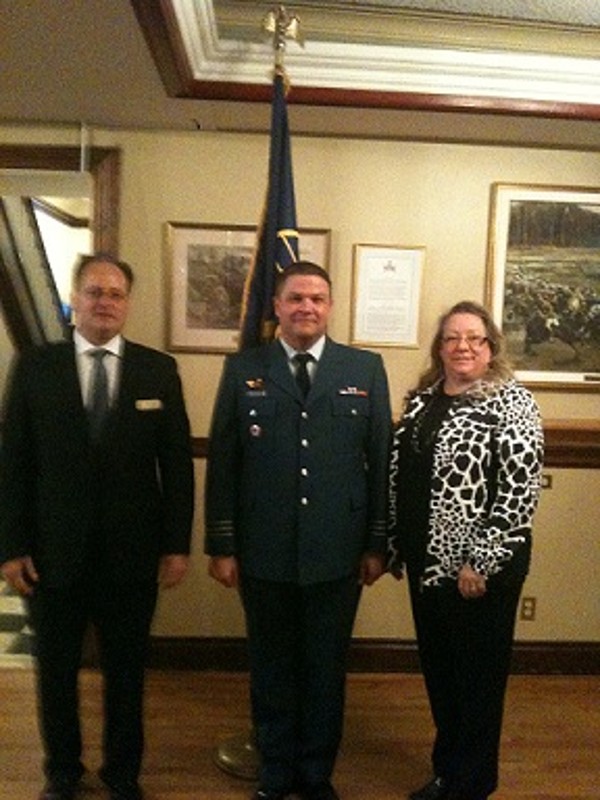 The chapter's October professional development luncheon featured guest speaker Lt. Col. Nick Torrington-Smith, commanding officer, Department of National Defence. The colonel presented "An Introduction to the Canadian Forces Electronic Warfare Centre."
The chapter's October professional development luncheon featured guest speaker Lt. Col. Nick Torrington-Smith, commanding officer, Department of National Defence. The colonel presented "An Introduction to the Canadian Forces Electronic Warfare Centre."
|
|
OTTAWA CHAPTER - 09/08/2015 |
|
OTTAWA CHAPTER - 06/05/2015 |
|
OTTAWA CHAPTER - 06/02/2015 |
OTTAWA CHAPTER - 05/05/2015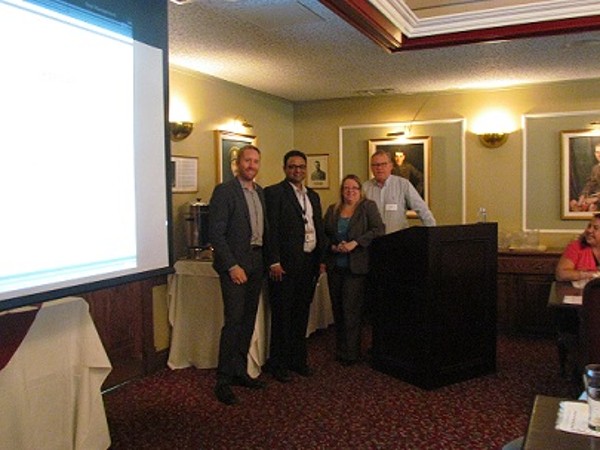 The chapter held a professional development luncheon in May sponsored by Intel Security. The guest speaker was Raj Thuppal of Shared Services Canada.
The chapter held a professional development luncheon in May sponsored by Intel Security. The guest speaker was Raj Thuppal of Shared Services Canada.
|
OTTAWA CHAPTER - 04/07/2015 The chapter's April luncheon focused on major DND projects and navigating through constrained budgets
The chapter's April luncheon focused on major DND projects and navigating through constrained budgets
|
OTTAWA CHAPTER - 03/03/2015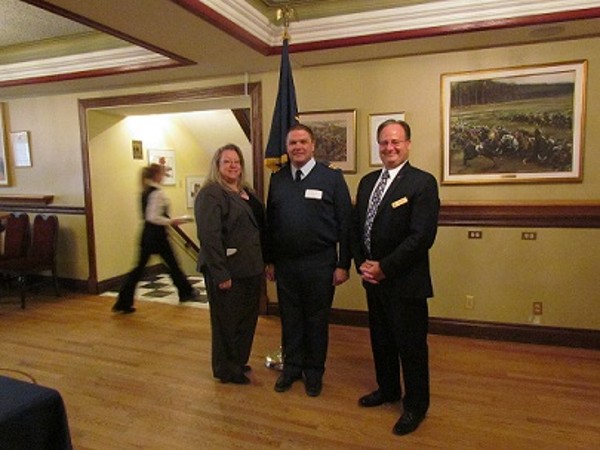 As the cyber domain grows, the Canadian Armed Forces (CAF) must take cyber operations into consideration. To this end, the Joint Cyber Operations Team (JCOT) is an integral piece of the Canadian Joint Operations Command (CJOC) team, which brings cyber subject matter expertise to planning efforts done at the operational level. A presentation to the chapter on this subject in March highlighted the roles and responsibilities of the JCOT and how cyber support to CAF operations is achieved.
As the cyber domain grows, the Canadian Armed Forces (CAF) must take cyber operations into consideration. To this end, the Joint Cyber Operations Team (JCOT) is an integral piece of the Canadian Joint Operations Command (CJOC) team, which brings cyber subject matter expertise to planning efforts done at the operational level. A presentation to the chapter on this subject in March highlighted the roles and responsibilities of the JCOT and how cyber support to CAF operations is achieved.
|
OTTAWA CHAPTER - 02/03/2015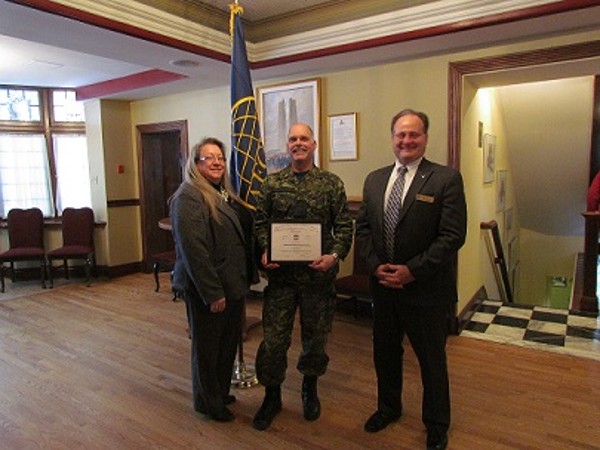 Lt. Col. Donald Mulders of the Department of National Defence spoke about the current challenges for the Canadian Joint Operations Command at the chapter's February luncheon. Topic: CJOC current challenges
Lt. Col. Donald Mulders of the Department of National Defence spoke about the current challenges for the Canadian Joint Operations Command at the chapter's February luncheon. Topic: CJOC current challenges
|
OTTAWA CHAPTER - 01/13/2015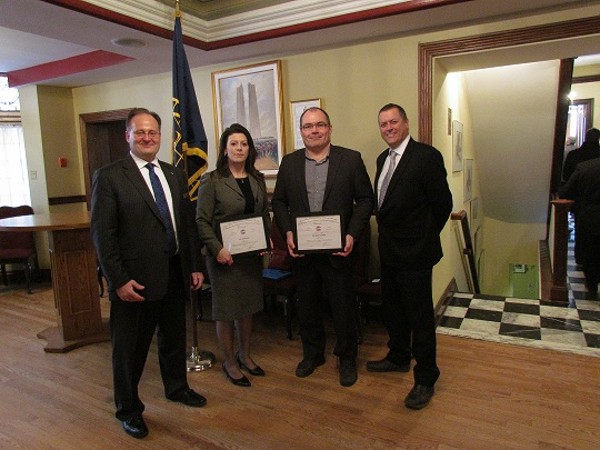 The January luncheon featured a high-level overview of the new Policy on Government Security (PGS) along with the new Standard on the Security of IT (SSIT to replace MITS).
The January luncheon featured a high-level overview of the new Policy on Government Security (PGS) along with the new Standard on the Security of IT (SSIT to replace MITS).
|
OTTAWA CHAPTER - 12/10/2014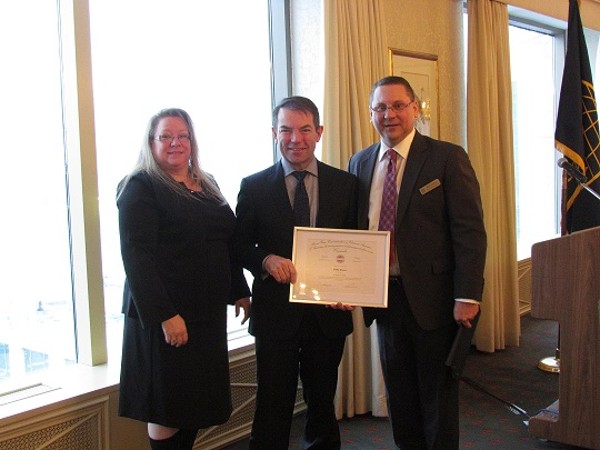 In December, guest speaker Peter Bruce, senior assistant deputy minister, Projects and Client Relationships, Shared Services Canada, gave an update on major SSC projects along with top priorities and challenges.
In December, guest speaker Peter Bruce, senior assistant deputy minister, Projects and Client Relationships, Shared Services Canada, gave an update on major SSC projects along with top priorities and challenges.
|
OTTAWA CHAPTER - 12/02/2014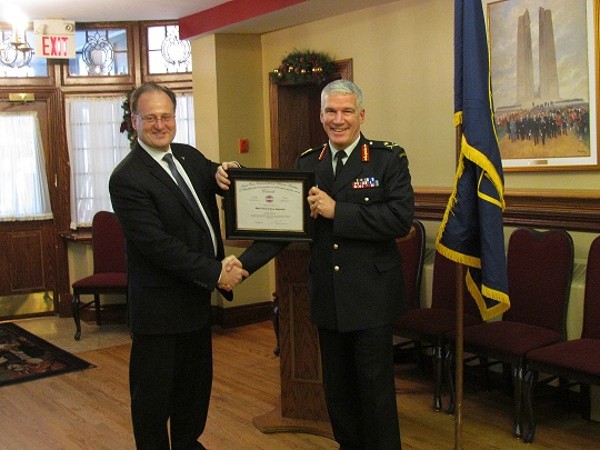 In December, the chapter hosted a special Christmas PD luncheon.
In December, the chapter hosted a special Christmas PD luncheon.
|
OTTAWA CHAPTER - 11/04/2014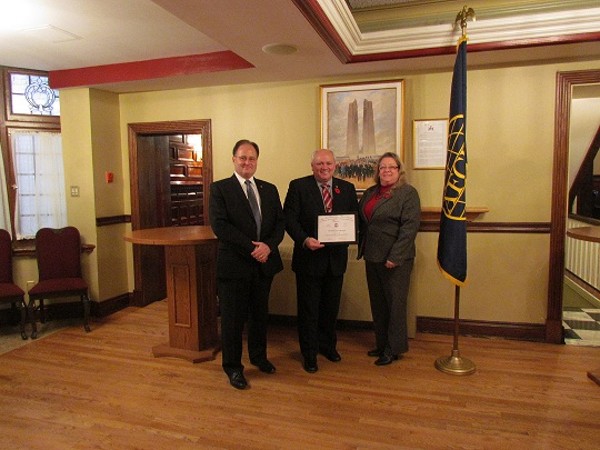 In November, Lt. Gen. Charles Bouchard, DND (Ret.), spoke on the evolution of aerial combat and related lessons learned through his recent command in Libya. He touched on the evolving political motivations of conflicts and how they have been addressed from World War I through to recent years. Gen. Bouchard is an officer of the Order of Canada; a commander of the Order of Military Merit; an officer of the U.S Legion of Merit, three oak leaf clusters; un Officier de la Lgion dHoneur (France); and a recipient of the Meritorious Service Cross. Lockheed Martin Canada sponsored the luncheon.
In November, Lt. Gen. Charles Bouchard, DND (Ret.), spoke on the evolution of aerial combat and related lessons learned through his recent command in Libya. He touched on the evolving political motivations of conflicts and how they have been addressed from World War I through to recent years. Gen. Bouchard is an officer of the Order of Canada; a commander of the Order of Military Merit; an officer of the U.S Legion of Merit, three oak leaf clusters; un Officier de la Lgion dHoneur (France); and a recipient of the Meritorious Service Cross. Lockheed Martin Canada sponsored the luncheon.
|
OTTAWA CHAPTER - 10/07/2014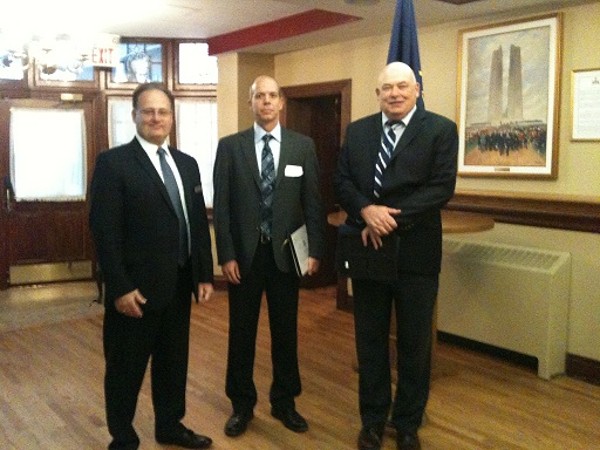 The chapter's October PD Luncheon featured an overview of the Canadian Safety and Security Program, presented by Dr. Mark A. Williamson, director general of Defense Research and Development Canada – Centre for Security Science (DRDC CSS). Dr. Paul Hubbard, defence scientist, DRDC CSS, also spoke on progress toward multiagency data and information exchange.
The chapter's October PD Luncheon featured an overview of the Canadian Safety and Security Program, presented by Dr. Mark A. Williamson, director general of Defense Research and Development Canada – Centre for Security Science (DRDC CSS). Dr. Paul Hubbard, defence scientist, DRDC CSS, also spoke on progress toward multiagency data and information exchange.
|
|
OTTAWA CHAPTER - 09/17/2014 |
|
OTTAWA CHAPTER - 09/09/2014 |
|
OTTAWA CHAPTER - 05/21/2014 |
|
OTTAWA CHAPTER - 06/03/2014 |
|
OTTAWA CHAPTER - 05/06/2014 |
|
OTTAWA CHAPTER - 04/01/2014 |
OTTAWA CHAPTER - 03/04/2014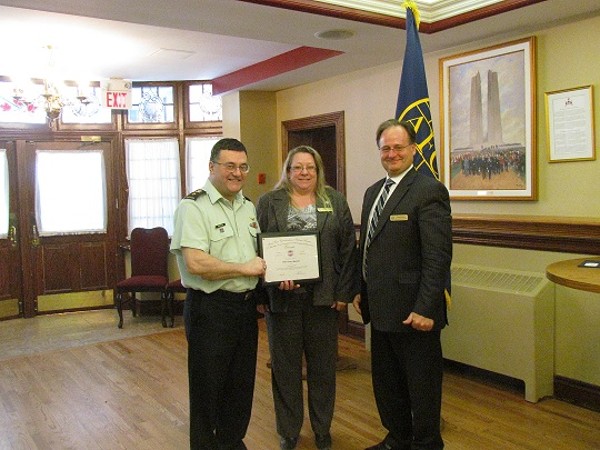 In March, the chapter welcomed guest speaker Brig. Gen. R.G. Mazzolin, OMM, CD, Canadian Armed Forces, director of general information management. The general spoke on the topic "Challenges and Opportunities in Contemporary Joint and Coalition Operations."
In March, the chapter welcomed guest speaker Brig. Gen. R.G. Mazzolin, OMM, CD, Canadian Armed Forces, director of general information management. The general spoke on the topic "Challenges and Opportunities in Contemporary Joint and Coalition Operations."
|
OTTAWA CHAPTER - 02/04/2014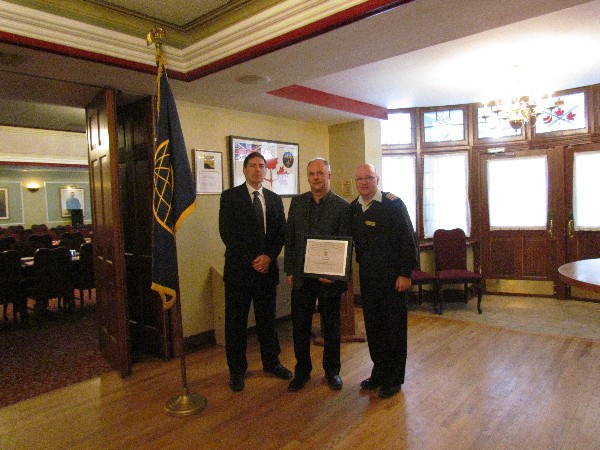 The chapter's February luncheon focused on the “Patriot Act Impact on Canadian Organizations Using Cloud Services.” The guest speaker was Scott N. Wright, president, Security Perspectives, and the luncheon sponsor was Trend Micro.
The chapter's February luncheon focused on the “Patriot Act Impact on Canadian Organizations Using Cloud Services.” The guest speaker was Scott N. Wright, president, Security Perspectives, and the luncheon sponsor was Trend Micro.
|
OTTAWA CHAPTER - 01/14/2014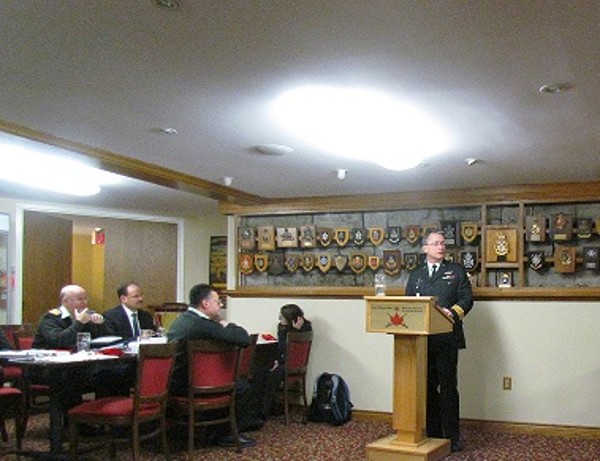 The chapter's January luncheon focused on "Signals within the Canadian Army: Some Current Challenges and Our Way Ahead," featuring guest speaker Col. Stephen W. Hall, Canadian Armed Forces, director of the Royal Canadian Corps of Signals, the director of land command and information and the Army G-6.
The chapter's January luncheon focused on "Signals within the Canadian Army: Some Current Challenges and Our Way Ahead," featuring guest speaker Col. Stephen W. Hall, Canadian Armed Forces, director of the Royal Canadian Corps of Signals, the director of land command and information and the Army G-6.
|
|
OTTAWA CHAPTER - 12/03/2013 |
OTTAWA CHAPTER - 10/24/2013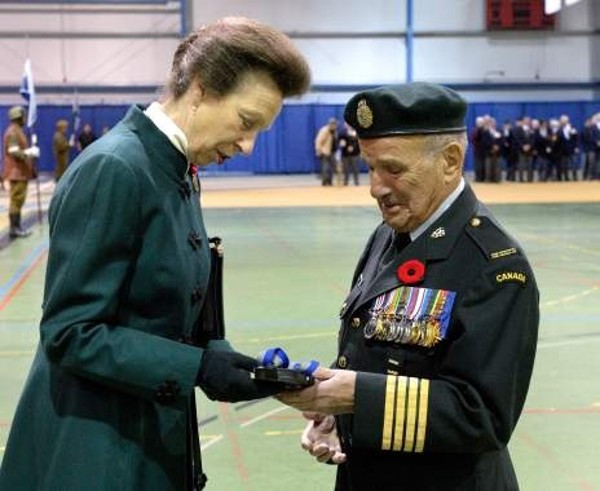 During October 24-25, chapter members gathered to watch while Her Royal Highness, The Princess Royal, Princess Anne, colonel-in-chief of the Communications and Electronics (C&E) Branch, was at the C&E Branch Home Station in Kingston, Ontario, to preside over celebrations during the 110th Anniversary of military communications in Canada. The C&E Branch Colonel-in-Chief Commendation was proposed to Her Royal Highness by the C&E Branch Leader, Maj. Gen. D.G. Neasmith to reward serving or retired branch members at the highest level possible for outstanding service to the C&E Branch. Having received approval, the inaugural awarding of the Colonel-in-Chief Commendation occurred during Her Royal Highness visit to Kingston during the 110the Anniversary celebrations. The Colonel-in-Chief Commendation consists of two items: a certificate and a medallion, which is both serialized and personalized with the name and rank of the recipient. During the inaugural year, Her Royal Highness awarded fou ... READ MORE
During October 24-25, chapter members gathered to watch while Her Royal Highness, The Princess Royal, Princess Anne, colonel-in-chief of the Communications and Electronics (C&E) Branch, was at the C&E Branch Home Station in Kingston, Ontario, to preside over celebrations during the 110th Anniversary of military communications in Canada. The C&E Branch Colonel-in-Chief Commendation was proposed to Her Royal Highness by the C&E Branch Leader, Maj. Gen. D.G. Neasmith to reward serving or retired branch members at the highest level possible for outstanding service to the C&E Branch. Having received approval, the inaugural awarding of the Colonel-in-Chief Commendation occurred during Her Royal Highness visit to Kingston during the 110the Anniversary celebrations. The Colonel-in-Chief Commendation consists of two items: a certificate and a medallion, which is both serialized and personalized with the name and rank of the recipient. During the inaugural year, Her Royal Highness awarded fou ... READ MORE
|
OTTAWA CHAPTER - 10/25/2013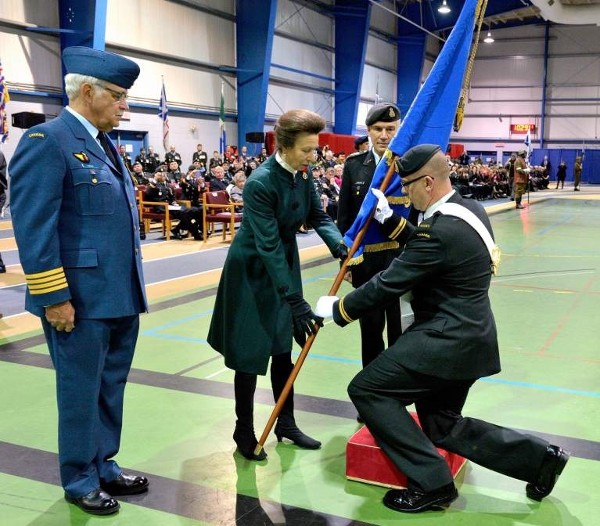 In October, chapter members gathered to watch as Her Royal Highness, The Princess Royal, Princess Anne, colonel-in-chief of the Communications and Electronics (C&E) Branch, visited the C&E Branch Home Station in Kingston, Ontario, to bestow Her Royal Banner to the C&E Branch on the 110th Anniversary of military communications in Canada. The Communications and Electronics Branch traces its roots back to October 24, 1903, when Maj. Bruce Carruthers' thesis advocating the formation of a specialized corps with a standardized visual signaling system was adopted and as a result the first signal corps in the British Empire, the Canadian Signalling Corps, was founded. In 1968 during the unification of the Canadian Armed Forces, existing communications and electronics organizations within the environments such as the Canadian Army's Royal Canadian Corps of Signals, the Royal Canadian Air Forces Telecommunications Branch and the Royal Canadian Navy's Communicators Supplementary were merged to ... READ MORE
In October, chapter members gathered to watch as Her Royal Highness, The Princess Royal, Princess Anne, colonel-in-chief of the Communications and Electronics (C&E) Branch, visited the C&E Branch Home Station in Kingston, Ontario, to bestow Her Royal Banner to the C&E Branch on the 110th Anniversary of military communications in Canada. The Communications and Electronics Branch traces its roots back to October 24, 1903, when Maj. Bruce Carruthers' thesis advocating the formation of a specialized corps with a standardized visual signaling system was adopted and as a result the first signal corps in the British Empire, the Canadian Signalling Corps, was founded. In 1968 during the unification of the Canadian Armed Forces, existing communications and electronics organizations within the environments such as the Canadian Army's Royal Canadian Corps of Signals, the Royal Canadian Air Forces Telecommunications Branch and the Royal Canadian Navy's Communicators Supplementary were merged to ... READ MORE
|
OTTAWA CHAPTER - 09/10/2013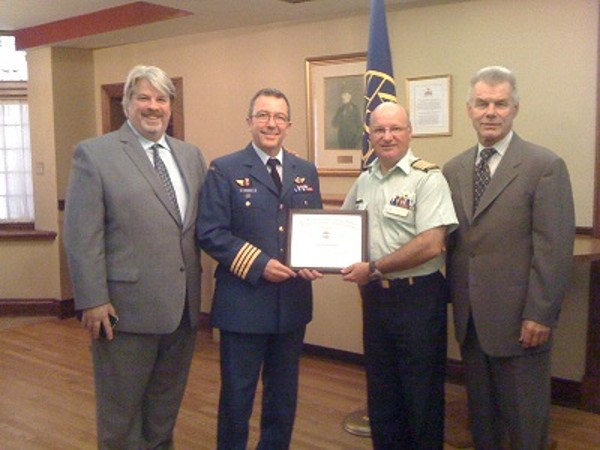 In September, the chapter welcomed Col. Andre Boucher, Canadian Armed Forces, director, cyber force development, Department of National Defence, to speak about cyber operations functional concepts.
In September, the chapter welcomed Col. Andre Boucher, Canadian Armed Forces, director, cyber force development, Department of National Defence, to speak about cyber operations functional concepts.
|
OTTAWA CHAPTER - 04/02/2013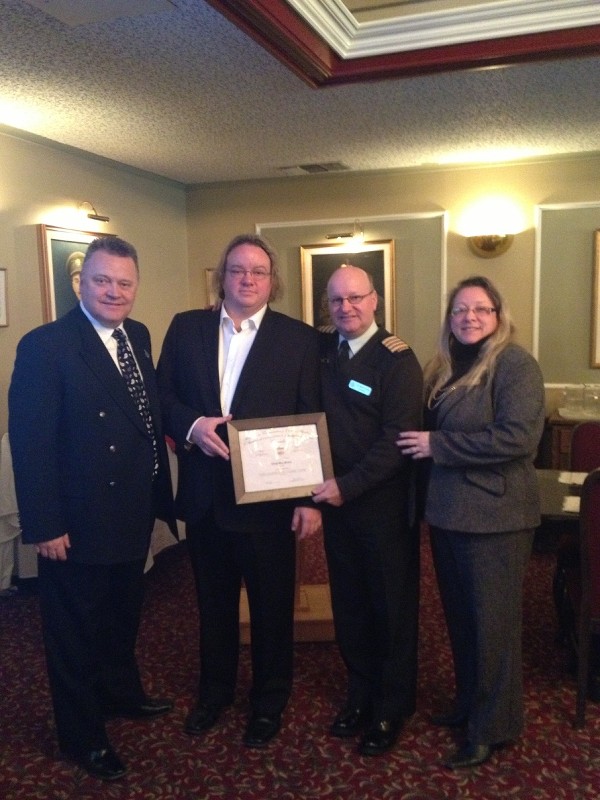 Chris Mac-Stoker, distinguished engineer and ED, product management, NIKSUN, addressed the chapter at its April luncheon. His speech was titled, “Surviving a Sophisticated Cyber Attack: A True Story.”
Chris Mac-Stoker, distinguished engineer and ED, product management, NIKSUN, addressed the chapter at its April luncheon. His speech was titled, “Surviving a Sophisticated Cyber Attack: A True Story.”
|
OTTAWA CHAPTER - 02/05/2013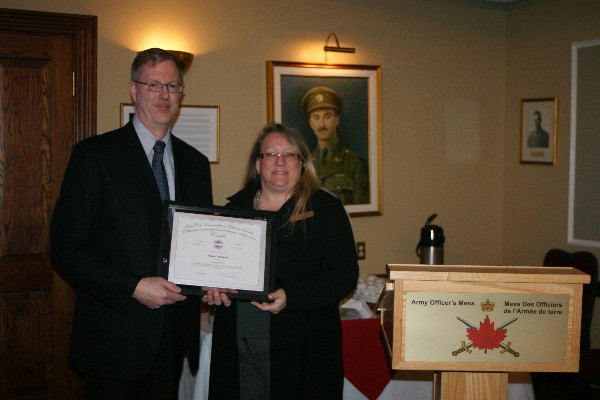 In February, the chapter held a luncheon focused on social media, security and privacy.
In February, the chapter held a luncheon focused on social media, security and privacy.
|
OTTAWA CHAPTER - 11/06/2012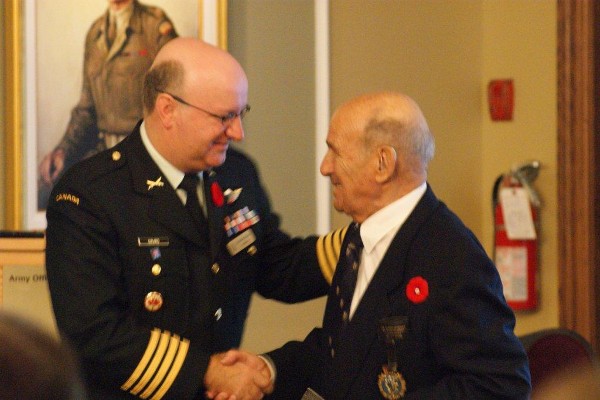 In November, the chapter recognized Lt. Col. D.L. Hart with the AFCEA International Distinguished Member Award. By the outbreak of World War II, Col. Hart became a lance corporal. He went overseas in early 1940 and landed at Dieppe as a sergeant in 1942. For his actions in this raid, the colonel was awarded the Military Medal by King George VI at Buckingham Palace. For full bio and other awards given to Col. Hart, please visit www.afceaottawa.ca under past events.
In November, the chapter recognized Lt. Col. D.L. Hart with the AFCEA International Distinguished Member Award. By the outbreak of World War II, Col. Hart became a lance corporal. He went overseas in early 1940 and landed at Dieppe as a sergeant in 1942. For his actions in this raid, the colonel was awarded the Military Medal by King George VI at Buckingham Palace. For full bio and other awards given to Col. Hart, please visit www.afceaottawa.ca under past events.
|
OTTAWA CHAPTER - 01/08/2013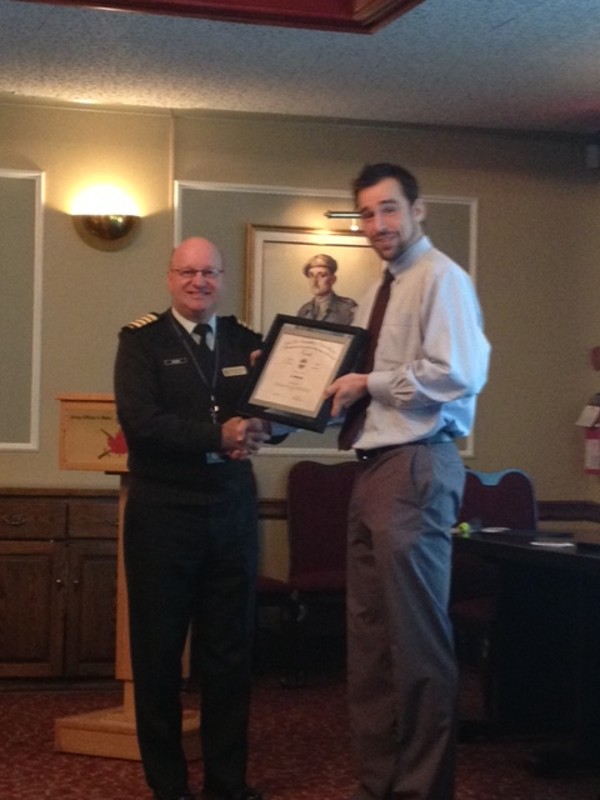 In January, the chapter welcomed Luc Beaudoin, chief of cyber operations, Canadian Cyber Incident Response Centre (CCIRC) – Public Safety Canada, as its guest speaker. The topic of this speech was, “Victim of a Cyber Attack? What your Organization May do and What Resources May be Available.”
In January, the chapter welcomed Luc Beaudoin, chief of cyber operations, Canadian Cyber Incident Response Centre (CCIRC) – Public Safety Canada, as its guest speaker. The topic of this speech was, “Victim of a Cyber Attack? What your Organization May do and What Resources May be Available.”
|

